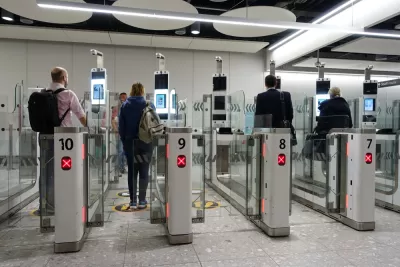Facial recognition offers both benefits and risks. Planners can have a role in ensuring more of the former than the latter.

Facial recognition is an increasingly utilized technology that offers, on the one hand, the chance to pay for things by looking into a camera instead of pulling credit cards out of their wallets. Some companies also depend on facial recognition to decrease theft or improve customer safety. On the other hand, facial recognition technology could be used by governments, law enforcement, and corporations to increase surveillance of private citizens beyond the traditional boundaries set by civil rights and privacy laws.
As the technology becomes a widely available option, city planners will likely be presented with facial recognition as a way to enhance 'smart city' technology. If that happens, though, planners might also be partially responsible for using facial recognition data carefully and protecting it against breaches.
City Planners May Help Tell the Public About Facial Recognition in Cities
Part of a city planner's job includes seeking feedback from residents about what people want or how they feel about proposed changes through public engagement processes. Thus, planners may be involved in telling residents that a locality is considering or intends to install facial recognition technology. If people don't receive that information promptly, they might blame planners.
In Perth, Australia, city authorities reportedly did not consult with residents before moving ahead with a face recognition trial. They did, however, confirm that officials would only honor facial recognition data requests from specific parties, such as law enforcement personnel.
Regardless of whether a city planner has ongoing access to the information collected by a face recognition system, they may play an instrumental role in helping people understand the crucial details about facial recognition trials. Additionally, they may explain the ways relevant parties will use the data and what a facial recognition camera tracks. The models used in some cities could, for instance, assist with traffic flow and pedestrian counts.
One way for planners to engage with the public about facial recognition in cities is to focus on the positives. For example, some organizers use facial recognition tech at conferences. It can recognize someone and print their badge in a few seconds. In the context of city living, such technology could speed the process of a person paying for or signing up to receive municipal services.
City Planners Must Become Familiar With Applicable Specifics
One of the complicated things about facial recognition is that the laws surrounding it vary by location. No federal legislation exists for it yet, but some municipalities—such as San Francisco, CA, and Somerville, MA—banned facial recognition tech. Other local authorities allow it, but only in specific instances. Places elsewhere are still debating the use, leaving its future in flux.
Before city officials get deep into the process of implementing facial recognition technology, they must ensure that the option will remain available for the foreseeable future. Investing in it could become wasteful otherwise, or it could become more challenging to secure the necessary funding.
Moreover, the infrastructure professionals who oversee these high-tech systems should investigate other options that don't necessarily detect people's faces. For example, Marbella, Spain, does not allow facial recognition cameras or the use of biometric data without a person's consent. However, the city has 85 cameras with artificial intelligence software that detects broader traits. For example, it identifies a person's hair color, gender, and approximate age.
If a city planner has access to facial recognition data for monitoring purposes or any other reason, they should take an active role in at least understanding the specifics surrounding the information use and storage. The company providing the services may offer a cloud-based service whereby the users do not need to store data themselves.
Even in that case, a city planner may be one of the many parties with authorized, ongoing access to facial recognition footage. If so, they should learn about and use any features that keep the information safe, such as two-factor authentication (2FA). If a city planner talks to the press, reporters may ask about the integration of facial recognition in cities. Having well-prepared, truthful and knowledgeable responses can reduce public uncertainty about the technology.
Planners Might Assume Partial Responsibility
As cities around the world continue to investigate the use of facial recognition technology, planning professionals will not likely be the sole parties associated with its introduction or management. However, anyone who researches the available options should choose entities that take the safety of user data seriously.
If a city planner investigates which companies offer the kind of facial recognition capabilities a location needs, they should also inquire about the cybersecurity measures in place. Does the organization have a robust internal infrastructure, plus offer measures that customers can avail of to protect data?
Many planners will also keep the public up to date about facial recognition trials or data usage policies. Giving people accurate and prompt information should reduce any negative assumptions and halt the spread of misinformation.
City officials should take responsibility by speaking up against any uses of facial recognition software that seem poorly coordinated or hastily devised. For example, if a local police department wants to start using facial recognition but keep the public in the dark about that approach, an infrastructure professional may weigh in with thoughts about why that idea could backfire and cause widespread mistrust.
The use of facial recognition in cities is an evolving possibility. Even if planners are not the sole authorities controlling the introduction or management of the technology, they should keep the public in mind and continually look for ways to protect data and privacy.

Maui's Vacation Rental Debate Turns Ugly
Verbal attacks, misinformation campaigns and fistfights plague a high-stakes debate to convert thousands of vacation rentals into long-term housing.

Planetizen Federal Action Tracker
A weekly monitor of how Trump’s orders and actions are impacting planners and planning in America.

In Urban Planning, AI Prompting Could be the New Design Thinking
Creativity has long been key to great urban design. What if we see AI as our new creative partner?

Pedestrian Deaths Drop, Remain Twice as High as in 2009
Fatalities declined by 4 percent in 2024, but the U.S. is still nowhere close to ‘Vision Zero.’

King County Supportive Housing Program Offers Hope for Unhoused Residents
The county is taking a ‘Housing First’ approach that prioritizes getting people into housing, then offering wraparound supportive services.

Researchers Use AI to Get Clearer Picture of US Housing
Analysts are using artificial intelligence to supercharge their research by allowing them to comb through data faster. Though these AI tools can be error prone, they save time and housing researchers are optimistic about the future.
Urban Design for Planners 1: Software Tools
This six-course series explores essential urban design concepts using open source software and equips planners with the tools they need to participate fully in the urban design process.
Planning for Universal Design
Learn the tools for implementing Universal Design in planning regulations.
planning NEXT
Appalachian Highlands Housing Partners
Mpact (founded as Rail~Volution)
City of Camden Redevelopment Agency
City of Astoria
City of Portland
City of Laramie






























